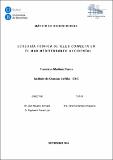Por favor, use este identificador para citar o enlazar a este item:
http://hdl.handle.net/10261/112557COMPARTIR / EXPORTAR:
 SHARE
BASE SHARE
BASE
|
|
| Visualizar otros formatos: MARC | Dublin Core | RDF | ORE | MODS | METS | DIDL | DATACITE | |

| Título: | Ecología trófica de Illex coindetii en el mar Mediterráneo occidental |
Autor: | Martínez, Francisco | Director: | Navarro, Joan CSIC ORCID; Rosas-Luis, Rigoberto CSIC ORCID | Fecha de publicación: | 22-sep-2014 | Editor: | Universidad de Barcelona CSIC - Instituto de Ciencias del Mar (ICM) |
Resumen: | The ommastrephid squid, Illex coindetii (Verany, 1983) is one of the most abundant cephalopod species in the northwestern Mediterranean and an important predator in the marine ecosystem. This study was carried out on individuals captured in 2013. The main objective was to know the trophic ecology of squids in the northwestern Mediterranean. The diet of I. coindetii was analyzed by the size, sex and season, combining two methods; stomach content analysis and stable isotopes analysis of δ13C y δ15N. The results showed that the diet of I. coindetii was composed by 35 taxonomic groups being the crustaceans Pasiphaea sivado and Plesionika sp., squid group (Theutida), Mictophids, other mesopelagic fishes and Amphipods the main components of its diet. Differences were found in the comparison between the diet and squid size. Smaller squids fed mainly on the shrimp P. sivado,whereas larger individuals fed on a wider range of prey items, such as the amphipod Anchylomera blossevillei, the decapod Plesionika sp., the gonostomatid Maurolicus muelleri, and some Mictophids species. Differences were also found throughout the year. In winter, crustaceans were the main prey items, whereas in summer the diversity of prey were higher, including fishes, crustaceans and mollusks. Isotopic results showed a similar pattern to the stomach content analysis. δ15N values were higher in larger squids than in smaller ones because they fed on prey with higher trophic levels. The results of the isotopic mixing model showed a long-term vision of the main prey items of the diet of I. coindetii, which was similar to the short-term vision of the stomach content analysis. In conclusion, this study shows that feeding habits of I. coindetii vary according to the size and season. These feeding variations may be associated with trophic competence scenarios among sizes, and also with the availability and abundance of prey throughout the year | Descripción: | Trabajo final presentado por Francisco Martínez Baena para el Máster en Biodiversidad de la Universitat de Barcelona (UB), realizado bajo la dirección del Dr. Joan Josep Navarro Bernabé y del Dr. Rigoberto Rosas del Institut de Ciències del Mar (ICM-CSIC).-- 36 pages, 7 figures, 1 annex | URI: | http://hdl.handle.net/10261/112557 |
| Aparece en las colecciones: | (ICM) Tesis |
Ficheros en este ítem:
| Fichero | Descripción | Tamaño | Formato | |
|---|---|---|---|---|
| Martinez_Baena_Trabajo_Master_2014.pdf | 633,44 kB | Adobe PDF |  Visualizar/Abrir |
CORE Recommender
Page view(s)
247
checked on 23-abr-2024
Download(s)
388
checked on 23-abr-2024
Google ScholarTM
Check
NOTA: Los ítems de Digital.CSIC están protegidos por copyright, con todos los derechos reservados, a menos que se indique lo contrario.
